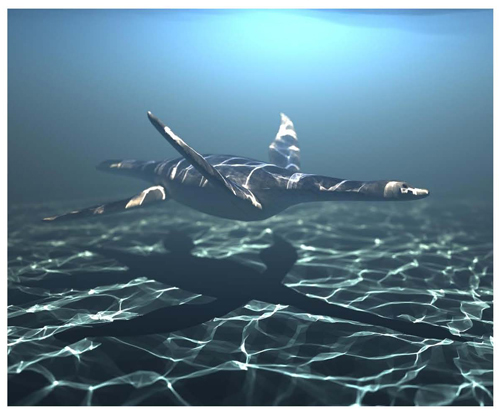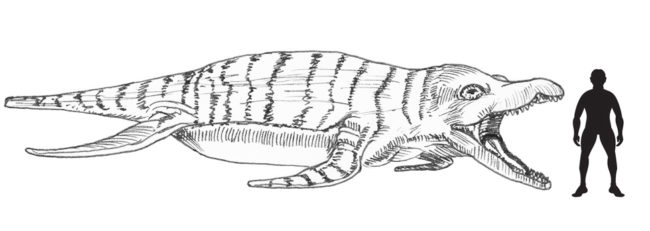Computer Simulations, Penguins, Plesiosaurs and Underwater Flight
Recently, Everything Dinosaur published an article on a fascinating piece of research published in the academic journal “PLOS Computational Biology” which focused on how plesiosaurs propelled themselves through the water. The paper had been written by researchers at the School of Interactive Computing, (Georgia Institute of Technology, Atlanta, Georgia, USA) with the collaboration of Dr Adam Smith (Nottingham Natural History Museum, Wollaton Hall, Nottinghamshire).
Plesiosaur Swimming Speed
A three-dimensional model of a plesiosaur based on the Early Jurassic Meyerasaurus was used to examine how this marine reptile might have swam. The computer simulations implied a forelimb dominated approach with the hind-limbs having a likely role not in active locomotion but in manoeuvring and stability.
Recently Published Paper Tackles How Plesiosaurs Moved in Water

The most effective swimming motion for the plesiosaur is flapping the two front flippers in an underwater flight motion
Picture credit: Royal Tyrrell Museum/Sabrowski/CP
In essence, these extinct reptiles may have “flown” through the water in the same way that extant penguins and turtles do today.
Swimming Plesiosaurs
One point team members at Everything Dinosaur picked up on was the velocities recorded during computer simulations of different limb configurations and different ranges of movement within the joints. The speeds seemed remarkably low to us, especially when one considers how robust some of the limb bones of plesiosaurs seem to be. A few weeks ago, team members were allowed to view some fossil bones from a plesiosaur that had been excavated over a series of dives off the coast of Dorset. The humerus (upper arm bone) in particular was most impressive and it obviously came from a large and powerful swimmer.
Swimming Speeds Recorded in the 3-D Study
Picture credit: Liu at el/PLOS Computational Biology
The bar graph above shows the speed of the best motions that were found by the optimisation for each of the joint ranges (narrow, medium, wide). They do not correspond to the maximum swimming speed likely to be achieved by a plesiosaur, although previous studies involving the plesiosaur genus used as the basis for the three-dimensional model (Meyerasaurus), suggested a swimming speed of around 0.4 metres/second.
Dr Smith Provides Clarification
We expressed our surprise with regards to the velocity cited in this research and emailed Adam Smith asking him to clarify the readings obtained. Dr Smith email swiftly back explaining:
“The speeds we reported are not estimates of maximum swimming speeds. We used speed only as a way to compare efficiency of simulations using all limbs versus simulations using just one pair of limbs (using identical joint ranges). Comparison between simulations under *different* joint ranges are meaningless because all the simulations have the same beat frequency. This is why the simulations with wider ranges are faster – the limbs move further in the same amount of time.”
The focus of this particular piece of research, the utilisation of state-of-the-art computer modelling to examine the locomotion of a Plesiosaur whose fossilised remains come from Lower Jurassic strata located in Germany, was on the range of motion of the limbs, calculating the maximum speed of the animal did not come within the parameters of the research brief.
Dr Smith added:
“If we put more energy into the simulations [by increasing the frequency of the limb beats] then they would certainly move more rapidly. However, we wanted to ensure that our swimming motions were biologically possible, so we made sure the beat frequency was quite conservative.”
The Plesiosaur Clade (Plesiosauria)
The plesiosaur clade (Plesiosauria) consists of a very wide variety of prehistoric creatures ranging in size from around 1.5 metres in length to more than 15 metres long. Swimming speeds are likely to have varied amongst species with different swimming abilities being consistent with different forms of feeding and hunting strategies.
To determine the maximum velocity of these creatures would involve calculating the muscle mass of a number of different sized individuals and looking at the influence on forward speed of different speeds of limb movement within a framework of what was biologically possible. In addition, the metabolism of the animal would have to be considered.
Papo have a number of marine reptiles in their model range including a Plesiosaurus figure: Papo Marine Reptile and Dinosaur Models.
Estimating Maximum Velocity
Dr Smith explained that estimating the maximum velocity of a plesiosaur was beyond the scope of this project but he teased:
“Maybe a future research project!”
Perhaps, we will have the answer one day to the theoretical question, how close to the beach would you have to be to allow you to escape before a large predatory marine reptile caught up with you?
How Much of a Head Start Would You Have Needed?
Picture credit: Everything Dinosaur
To read the recent article which highlighted the research into the locomotion of plesiosaurs: Computer Simulations, Penguins, Plesiosaurs and Underwater Flight.








it is not clear